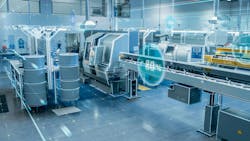How Open Systems Enable Practical IIoT Data Use
June 27, 2024
3 min read
With so many technologies coming at the manufacturing industries—from the edge and cloud to artificial intelligence—it can be easy to be overwhelmed by it all and become unsure of how to move forward or what technology to move forward with. But the reality is that, for many of these technologies, their application has become far easier to apply and gain measurable benefits from them.
At Automate 2024, Ken Crawford of Weidmuller showed how easy it’s become to collect Industrial Internet of Things (IIoT) data wirelessly over a distance of several miles for applications between multiple facilities at a site or with field-deployed installations.
His example focused on capturing solar energy from solar panels to power devices at an industrial facility. The voltage and current from the solar panels are converted and scaled with Weidmuller signal conditioners and transmitted to a Weidmuller wireless I/O radio that can then send the data to a receiving wireless I/O radio in another location. Because Weidmuller’s wireless I/O radios have built-in intelligence, any analog data received by the radio is digitized for Modbus TCP to be read by a PLC.
In Crawford’s demonstration (see video below), a Weidmuller edge agent reads the variables from a Weidmuller UC20 PLC and converts them into human readable values and sends them wirelessly via Wi-Fi to an iPad that can be used as a mobile dashboard.
“IIoT is really about data collection and storage and the ability to forward the data to people who can use it,” Crawford said. “So, what we're doing is we're taking the power from the solar panels and converting it into common voltage and current to power the demo’s wind turbine. So really, it's about ease of digitization and ease of using that data. You just wire this up with no programming or scripting. It's simple data in and data out.”
This ease of data capture use can also be put into play for monitoring critical systems in a manufacturing operation. Crawford showed an example of this for remote monitoring of an uninterruptable power supply (UPS) to monitor such details as: Is the UPS is running? How many times it’s been cycled? How long has it been running in offline mode? All of this data about the UPS can be accessed remotely when needed and messages can be sent automatically to key personnel when any event with a monitored device occur.
Dashboard screens can also be configured to alert operators about a system’s status.
Crawford pointed that a key aspect of the data in/data out ease with which IIoT applications can be developed depend on having an open ecosystem like Weidmuller’s uOS, which the application was running “containerized” on the UC20 PLC in Weidmuller’s exhibit at Automate. With containers, users can run Codesys on the PLC as an IEC-61131 standard language, run Node Red, or even load an Ignition module from Inductive Automation.
“This isn't a closed platform that requires users to deal only with the capabilities that are issued from Weidmuller,” Crawford added.
About the Author
David Greenfield, editor in chief
Editor in Chief
David Greenfield joined Automation World in June 2011. Bringing a wealth of industry knowledge and media experience to his position, David’s contributions can be found in AW’s print and online editions and custom projects. Earlier in his career, David was Editorial Director of Design News at UBM Electronics, and prior to joining UBM, he was Editorial Director of Control Engineering at Reed Business Information, where he also worked on Manufacturing Business Technology as Publisher.
Sign up for our eNewsletters
Get the latest news and updates

Leaders relevant to this article:

